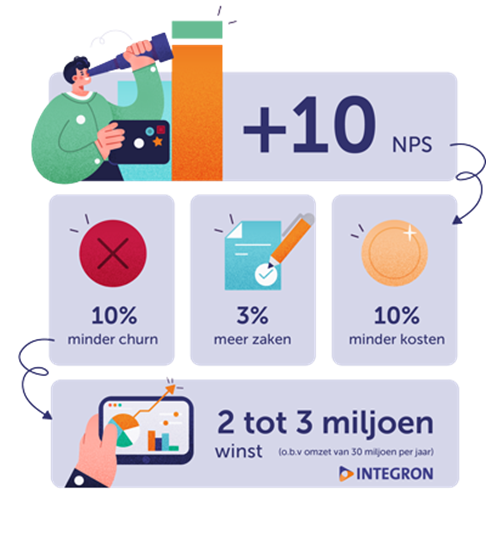Here’s what really working on CX will get you
The Net Promoter Score (NPS) had been on the rise since 2016. From an average of +7 to +16 by 2021. This year, for the first time in ages, we see a stagnation in the NPS (+15). A shift in trend. That is. Something to be dramatic about? Not that. But it does mean that organizations within B2B Netherlands are missing out on sales and profits. Maybe your organization will too. Because the higher the NPS, the more enthusiastic customers you have. They talk positively about you, recommend you, return and do more business with you. It also attracts potential new customers. All in all, you are building a more stable customer base and achieving positive financial results, or return on investment (ROI). Because with more enthusiastic, recommending customers (promoters), you can ensure sales increases that are quite higher than those of organizations lower on the NPS ladder. So how do you improve your ROI when you start working concretely and structurally with your customer experience and NPS, investing in your customers? I explain.
So what is this NPS? This is an important metric to measure customer loyalty. To your customers ask the NPS question, “how likely are you to recommend us to a colleague or relation? This answer is expressed on a scale of 0 to 10. Customers can then be divided into three groups: promoters, passives and detractors. Promoters give you a 9 or 10. Could hardly be better. They are really enthusiastic and actively recommend you. Passives give you a 7 or 8. They are satisfied, but not overly enthusiastic. Detractors give you a score between 0 and 6. So they are dissatisfied and hardly recommend you. To calculate the NPS, subtract the percentage of detractors from the percentage of promoters. It will come as no surprise to our ears when we say that, as an organization, you need to ensure more promoters and fewer detractors. And the passives are definitely a group you can still “get more out of. Our recent Customer Experience survey shows that 50% of customers within B2B Netherlands are passive. So here is a huge potential for the future.
Make a difference
Why is working on a high NPS and on your CX so important? Well, when your customers are highly satisfied and recommend your organization, you are really making a difference. Good for your (brand) name and for building your cash flow. Now and in the future. This is not a matter of doing a customer satisfaction survey in between, but an integral process that requires continuous attention. In doing so, you need to have a plan and set goals to focus on. In short, a customer experience (CX) strategy. At Integron, we see daily that organizations that have their CX strategy, customer journey and “feedback utilization” in order from research, among other things, are working passionately on their CX and thus a higher NPS. CX must go into the DNA of your organization from top to bottom. At the strategic level through directors and management teams, at the tactical level through unit and BU managers and team leaders, and operationally through executive staff. But you make the beginning top down at the strategic level. Know where you want your organization to go and how you want to optimize the customer and also the employee experience. You can hire internal customer experience managers for that or outsource it to specialists who have the right knowledge to do so.
In addition to bringing in professionals, it is important that CX be given a prominent place in the various structures/consultations and tasks (governance) so that there is focus, attention and budget on the topic. It is also important to know what your customers want. Listen to them and ask what they need and what could be different or better. Examine this frequently to gain insight. Leverage the feedback obtained and continuously improve. CX research and feedback utilization succeed when you work from a plan in which you clearly describe the goals/KPIs (metrics) you want your organization to achieve. If necessary, you can adjust and optimize. Also map the customer journey. Talk about good and lasting relationships with customers. Through closed feedback loops, you can work optimally and continuously on customer experience/enthusiasm. Basically, it comes down to getting feedback from your surveys/surveys, processing it and then following up and feeding back improvements to the customer as soon as possible. This is done at the organizational level, with some solutions required integrally or structurally (structural follow-up). But sometimes it involves customization. For example, that you work on improvement through the feedback obtained per individual business unit (individual follow-up). In practice, it is often a combination of both.
Get fewer customers to go to competitors, lower your churn rate
That there is a dire need to work on your CX and NPS shows “churn rate” figures. 27% average of B2B customers leave an organization per year and thus 27% loss of your revenue! (source: CustomerGauge). This is often due to poor service, poor communication, poor complaint handling and better products and services at competitors. All reasons for customers to switch to that competitor. A churn rate, meaning customers who drop out within your group of existing customers, that is good to call, is generally below 5% on average. Depending on the industry and type of customers. A high churn rate entails huge costs. For example, attracting new customers costs seven times as much as retaining an existing customer (source: Salesforce). These include acquisition and marketing costs. In addition, a returning customer is much more likely to do more business with you. This does add up to 33% more business per client. How much cost can you save? Calculate it with our CX ROI calculator.
Did you know that promoters are cheaper than marketing?
Obviously, you want attention for your business. A little organization invests in marketing. Especially in larger companies, marketing budgets take up a significant portion of annual sales. Reducing a marketing budget from 15% to 10% already pays off big time. Marketing is also less necessary when there are more promoters. Then the promotership does its job. Word of mouth is then an important marketing channel. Loyal customers provide “free” ads because they recommend you. Not unimportant at a time when competition is increasing, consumers have more choice and thus do not automatically choose your brand or service.
Work on happy customers
Our motto is: work on happy customers! Get concrete with your NPS. For example, a +10 increase in NPS can lead to:
- 10-15% less churn, so fewer customers switching to competitors.
- 3% more business within your overall customer base;
- 10-15% reduction in marketing costs.
All this will get you quite a bit. For an organization with revenues of 30 million euros per year, this could easily be a savings or revenue of 2 to 3 million euros. Count your winnings!
Want to know more about ROI and making NPS rise?
Working on the customer experience and NPS is a continuous and integral process. Long-term partnerships with clients allow us to get the best out of both client and employee. We have proven that in practice. Contact me.
At a time when the job market is constantly evolving and competition for talent is high, a well-structured onboarding process plays a crucial role in attracting and retaining valuable employees. In this article, we dive into why thoughtful onboarding is crucial, what it entails and some strategies to achieve an optimal onboarding experience.
Measuring customer satisfaction is invaluable in today's competitive marketplace. Customer satisfaction surveys (KTO) provide organizations with insight into their customers' expectations and experiences. This is essential for improving customer loyalty. Integron supports companies in conducting these surveys. Thus, we not only provide valuable data but also develop complete strategies to strengthen their customer relationships. In this blog, we explain why a KTO is a strategic tool for improving your services and creating satisfied and loyal customers.
The industry continues to do well. Also in the past year, the industry was overwhelmingly on the right side of the line and, along with wholesale, has the most loyal and enthusiastic customers in B2B Netherlands.




